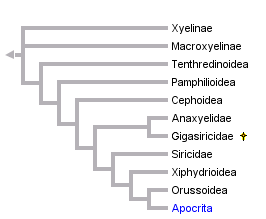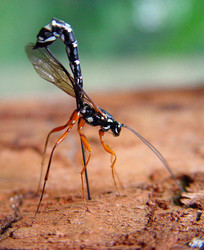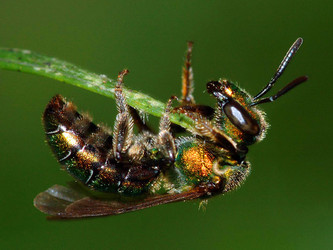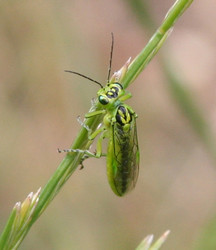Hymenoptera
Wasps, ants, bees, and sawflies



This tree diagram shows the relationships between several groups of organisms.
The root of the current tree connects the organisms featured in this tree to their containing group and the rest of the Tree of Life. The basal branching point in the tree represents the ancestor of the other groups in the tree. This ancestor diversified over time into several descendent subgroups, which are represented as internal nodes and terminal taxa to the right.

You can click on the root to travel down the Tree of Life all the way to the root of all Life, and you can click on the names of descendent subgroups to travel up the Tree of Life all the way to individual species.
For more information on ToL tree formatting, please see Interpreting the Tree or Classification. To learn more about phylogenetic trees, please visit our Phylogenetic Biology pages.
close boxReferences
Carpenter, J. M., and W. C. Wheeler. 1999. Towards simultaneous analysis of morphological and molecular data in Hymenoptera. Zoologica Scripta 28(1-2):251-260.
Crozier, R. H. 1975. Hymenoptera. Borntraeger, Berlin; Stuttgart.
Danforth, B. D. 1989. The evolution of hymenopteran wings: The importance of size. Journal Of Zoology 218(2):247-276.
Gauld, I. and Bolton, B. 1988. The Hymenoptera. British Museum (Natural History); Oxford University Press, London; Oxford; New York.
Gibson, G.A.P. 1985. Some pro- and mesothoracic structures important for phylogenetic analysis of Hymenoptera, with a review of terms used for the structures. Can. Ent. 117:1395-1443.
Goulet, H. and J. T. Huber. 1993. Hymenoptera of the world: an identification guide to families. Agriculture Canada Research Branch Monograph no. 1894E.
Johnson, N. F. 1988. Midcoxal articulations and the phylogeny of the order Hymenoptera. Annals Of The Entomological Society Of America 81(6): 870-881.
Krombein, K. V. 1979. Catalog of Hymenoptera in America north of Mexico. Smithsonian Institution Press, Washington.
Quicke, D. L. J., M. G. Fitton, et al. 1992. Phylogenetic implications of the structure and distribution of ovipositor valvilli in the Hymenoptera (Insecta). Journal Of Natural History 26(3):587-608.
Quicke, D. L. J., S. N. Ingram, et al. 1992. Sperm structure and ultrastructure in the Hymenoptera (Insecta). Zoologica Scripta 21(4):381-402.
Ronquist, F. 1999. Phylogeny of the Hymenoptera (Insecta): The state of the art. Zoologica Scripta 28(1-2):3-11.
Ronquist, F., A.P. Rasnitsyn, A. Roy, K. Eriksson, and M. Lindren. 1999. Phylogeny of the Hymenoptera: A cladistic reanalysis of Rasnitsyn's data (1988) data. Zoologica Scripta 28:13-50.
Saini, M. S. 1986. Comparative studies on the metapostnotal modifications in suborder Symphyta and Hymenoptera Parasitica. Journal Of Entomological Research 10(1):85-90.
Schulmeister, S. 2003. Morphology and evolution of the tarsal plantulae in Hymenoptera (Insecta), focussing on the basal lineages. Zoologica Scripta 32:153-172.
Schulmeister, S. 2003. Review of morphological evidence on the phylogeny of basal Hymenoptera (Insecta), with a discussion of the ordering of characters. Biological Journal of the Linnean Society 79:209-243.
Schulmeister, S. 2003. Simultaneous analysis of basal Hymenoptera (Insecta): introducing robust-choice sensitivity analysis. Biological Journal of the Linnean Society 79:245-275.
Schulmeister, S., W. C. Wheeler, and J. M. Carpenter. 2002. Simultaneous analysis of the basal lineages of Hymenoptera (Insecta) using sensitivity analysis. Cladistics 18:455-484.
Sharkey, M. J. 2007. Phylogeny and Classification of Hymenoptera. Pages 521-548 in: Zhang, Z.-Q. & Shear, W.A., eds. Linnaeus Tercentenary: Progress in Invertebrate Taxonomy. Zootaxa 1668:1–766.
Sharkey, M. J. and A. Roy. 2002. Phylogeny of the Hymenoptera: a reanalysis of the Ronquist etal. (1999) reanalysis, emphasizing wing venation and apocritan relationships. Zoologica Scripta 31:57-66.
Vilhelmsen, L. 1997. The phylogeny of lower Hymenoptera (Insecta), with a summary of the early evolutionary history of the order. Journal of Zoological Systematics and Evolutionary Research, 35:49-70.
Vilhelmsen, L. 2000. The ovipositor apparatus of basal Hymenoptera (Insecta): phylogenetic implications and functional morphology. Zoologica Scripta 29:319-345.
Vilhelmsen, L. 2001. Phylogeny and classification of the extant basal lineages of the Hymenoptera (Insecta). Zoological Journal of the Linnean Society 131:393-442.
Whitfield, J. B., N. F. Johnson, et al. 1989. Identity and phylogenetic significance of the metapostnotum in nonaculeate Hymenoptera. Annals Of The Entomological Society Of America 82(6):663-673.
Information on the Internet
- HymAToL. A project funded by the National Science Foundation under the “Assembling the Tree Of Life” initiative. It aims to construct a large-scale phylogenetic analysis of the Hymenoptera.
- The International Society of Hymenopterists
- Hymenoptera Name Server (Ohio State University)
- The Social Insects Web (American Museum of Natural History)
- Cal Academy Hymenoptera
- CSIRO Hymenoptera Ecowatch
- Hymenoptera Families (INBIO, Costa Rica)
- Introduction to the Hymenoptera at UCMP Berkeley
- Introduction to the Hymenoptera (USDA)
Title Illustrations

| Scientific Name | Rhyssa persuasoria |
|---|---|
| Specimen Condition | Live Specimen |
| Behavior | giant ichneumon wasp boring the surface of fir trunk infested with wood wasp larvae |
| Sex | Female |
| Life Cycle Stage | adult |
| Source | #9008009 |
| Source Collection | Bugwood Network/Forestry Images |
| Image Use |
 This media file is licensed under the Creative Commons Attribution-NonCommercial License - Version 3.0. This media file is licensed under the Creative Commons Attribution-NonCommercial License - Version 3.0.
|
| Copyright | © Boris Hrasovec, University of Zagreb |
| Scientific Name | Agapostemon virescens |
|---|---|
| Location | Maryland, United States |
| Specimen Condition | Live Specimen |
| Life Cycle Stage | adult |
| Source | #1366072 |
| Source Collection | Bugwood Network/Forestry Images |
| Image Use |
 This media file is licensed under the Creative Commons Attribution License - Version 3.0. This media file is licensed under the Creative Commons Attribution License - Version 3.0.
|
| Copyright | © Susan Ellis |
| Scientific Name | Rhogogaster viridis |
|---|---|
| Location | Felmersham Gravel Pits, Bedfordshire, UK |
| Specimen Condition | Live Specimen |
| Source | sawfly - Rhogogaster viridis |
| Source Collection | Flickr |
| Image Use |
 This media file is licensed under the Creative Commons Attribution-NonCommercial-NoDerivs License - Version 2.0. This media file is licensed under the Creative Commons Attribution-NonCommercial-NoDerivs License - Version 2.0.
|
| Copyright | © 2006 Katie |
About This Page
Page copyright © 1995
All Rights Reserved.
Citing this page:
Tree of Life Web Project. 1995. Hymenoptera. Wasps, ants, bees, and sawflies. Version 01 January 1995 (temporary). http://tolweb.org/Hymenoptera/8232/1995.01.01 in The Tree of Life Web Project, http://tolweb.org/











 Go to quick links
Go to quick search
Go to navigation for this section of the ToL site
Go to detailed links for the ToL site
Go to quick links
Go to quick search
Go to navigation for this section of the ToL site
Go to detailed links for the ToL site